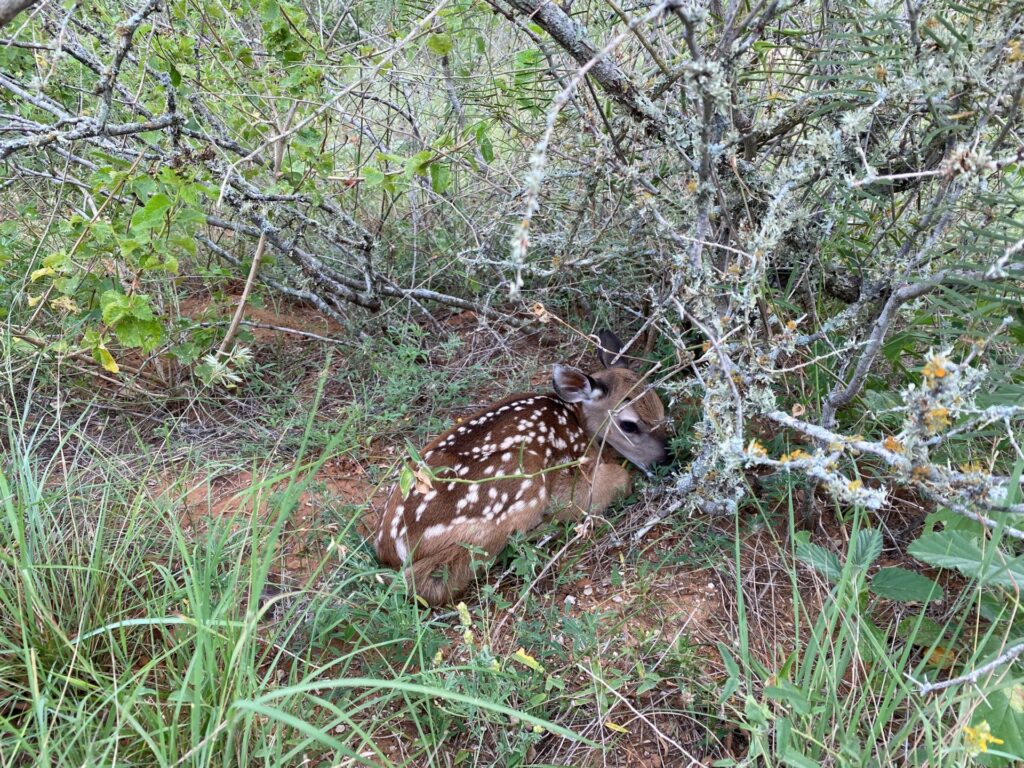- Fragile Planet Offers a Nighttime Wildlife Experience
- Falcons Soccer Off & Running
- Cameron County Receives Funds to Improve Two Parks
- Falcons Complete First Half of 32-6A
- School District to Help out Victims of California Wildfires
- Sand Castle Days Continued Despite Unexpected Weather
- Ready for District
- Discussion of Garbage Dumpster Rates, Agreements Between State & City on Highway Regulations, and More
- 31st Annual Shrimp Cook-Off is Right Around the Corner
- LFHS Cross Country
Oh, Deer! Leave Fawns Where You Find Them
- Updated: July 23, 2023
AgriLife Extension wildlife specialist encourages Texans not to disturb, remove fawns found alone

Written by Sarah Fuller
It’s a tale as old as time: buck meets doe, buck pursues doe and nature takes its course. Some 200 gestational days later, many lucky Texans will encounter the outcome of this yearly ritual as the next generation of deer are born.
Few things illicit a response from humans quite like that of encountering juvenile wildlife. It is undoubtedly a remarkable experience, providing an often-unseen glimpse into the behavior and life cycle of some of the state’s most beloved species.
Because deer breeding season spans from early fall through winter, fawns can be born as early as April or as late as July the following year. And while these young deer undoubtedly face threats from predators, both doe and fawn are equipped with a suite of natural adaptations and behaviors to avoid potential predation.
However, Jacob Dykes, Ph.D., Texas A&M AgriLife Extension Service wildlife specialist, Corpus Christi, said strategies used by deer to keep fawns safe are often misinterpreted by well-meaning passersby.
“Each year, there are many cases of people stumbling across bedded fawns that appear to be abandoned,” said Dykes, who also serves as assistant professor in the Department of Rangeland, Wildlife and Fisheries Management in Texas A&M’s College of Agriculture and Life Sciences. “If you are one of those people, you are tasked with a great responsibility. You have the responsibility to back away and leave the fawn alone.”
The Texas Parks and Wildlife Department reports that a state-certified wildlife rehabilitator study found in some years, 40% or more of the fawns referred to them for care were not orphaned or injured, but inadvertently taken from their mothers.
To shed light on the natural behaviors of deer and prevent the wrongful taking of fawns, we spoke with Dykes to learn more.
Following birth, what actions does a doe take to ensure the safety of its fawns?
There are a few strategies and adaptations deer use to keep fawns safe. Immediately after the fawn is born, the doe will consume the afterbirth and lick the fawn all over to remove scents that may attract predators. It is a myth that fawns are born odorless and, in reality, their odor helps mom find them when they get separated.
Within 10 hours of birth, a doe will move the fawn to another area, and the fawn will instinctively bed down in vegetation. If the doe has multiple fawns, she will actually separate them to improve the chances of at least one surviving.
While bedded, fawns lie very still and will lower their heart rate by over 30% when alarmed, which helps them remain undetected when predators are nearby. This behavior and their spotted fur, known as cryptic coloration, help them blend into the environment.
Do fawns remain with their mother at all times after birth?
Not at all. Another predator-avoiding strategy, and the one likely responsible for the “abandoned” fawn idea, is that a doe will leave the fawn bedded alone. She does this so her own presence and scent won’t attract predators. In fact, for the first few weeks of life, the doe and fawn spend most of their time apart.
The doe rarely ventures more than 100 yards away and returns a few times a day just long enough to nurse the fawn. While nursing, the doe will lick the fawn to stimulate waste release, then consume the waste so the odor doesn’t attract predators.
Fawns grow quickly, so in just a few hours they’re already testing their ability to walk. Within a few days, they’re too quick for humans to catch. After about three weeks, fawns start eating a little vegetation, and weaning typically occurs at 12 to 16 weeks of age.
Will the mother reject a fawn after a human has touched it?
A doe will not reject her fawn if a human has touched it. The idea of human scent causing wildlife to reject their young is a misconception also commonly believed in the case of baby birds and small mammals. If you have touched the fawn or even removed it from the area, it should be returned immediately. It is illegal to possess a fawn, and research shows that captive-raised fawns are not likely to survive when returned to the wild, mainly due to a lack of survival skills.
At least one study indicates that while released fawns can die from many different causes, the majority are killed by predators. This is true for both hard and soft releases from captivity.
Is there ever a case in which citizen intervention is justified? If so, what steps should be taken?
There are certain situations in which a game warden should be notified, and this typically involves a fawn being in a place where it shouldn’t be. For example, if you find a fawn in a parking lot or place of business, contact a game warden so the fawn can be safely removed.
Around a home, residents might find a fawn bedded down in a flower bed. In such a case, it’s best to leave the fawn alone and secure any pets, such as dogs, that might harass the fawn or prevent the mother from returning. In cases warranting intervention, game wardens should always be the first point of contact for concerned residents.
Identify the game wardens who serve your county to have their contact information on hand. We all have a soft spot for fawns, so let’s work together to ensure they have the best chances of survival.



